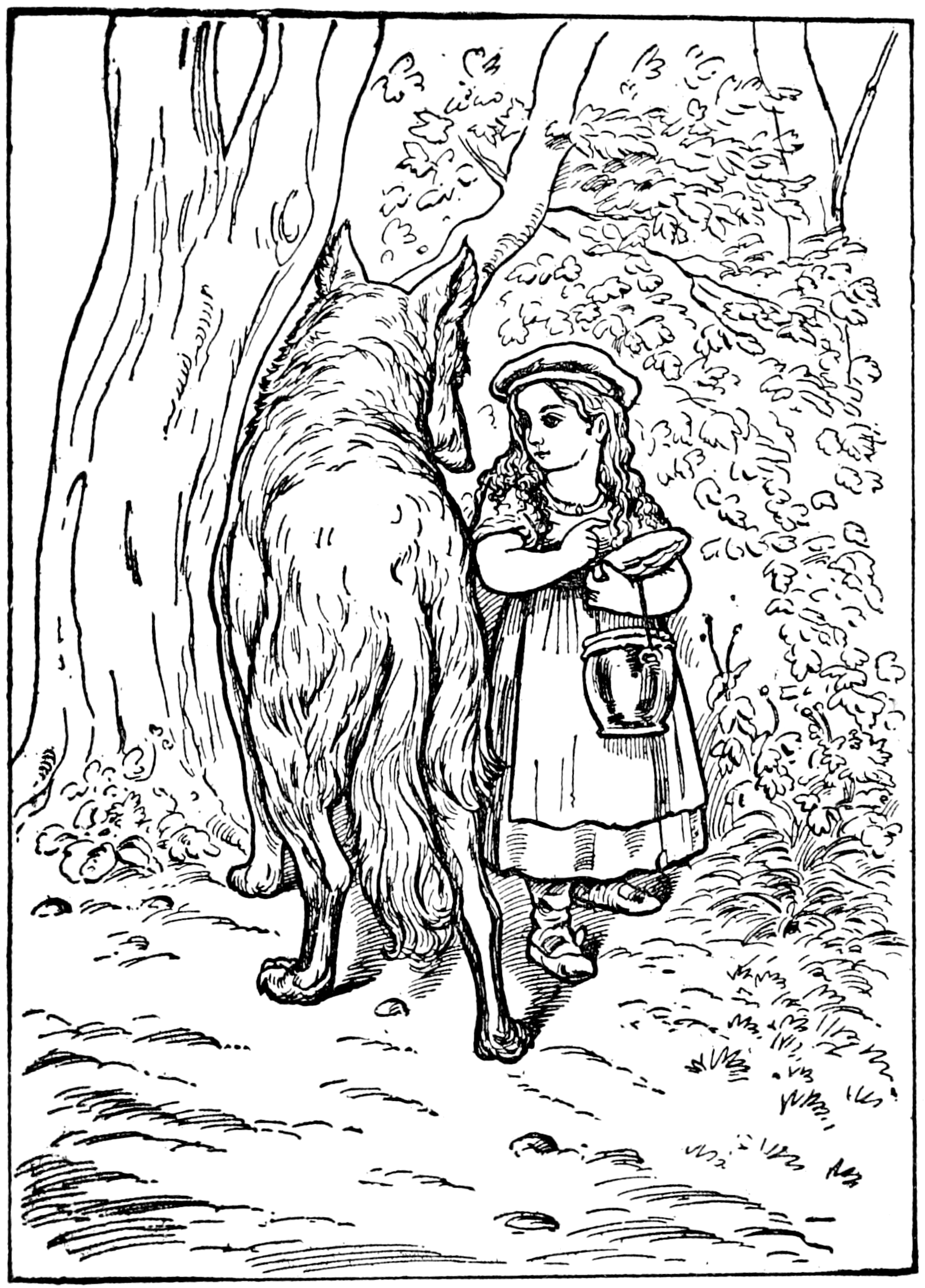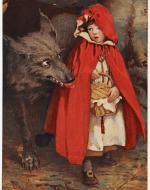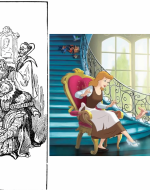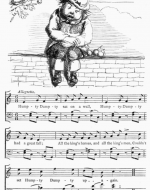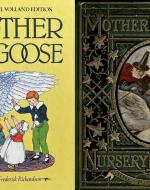Created by Sarah Miller on Sun, 10/20/2024 - 16:02
Description:
The Tales of Mother Goose is comprised of a treasure trove of fairy tales and nursery rhymes that are fundamental to the genre of children’s literature. The original collection included eight folktales that were passed down for generations before being published by French author Charles Perrault in 1696. Published as Histoires ou contes du temps passé, which translates to "Stories or Tales from Past Times," includes an old woman on the cover weaving while telling stories to children. As it grew in popularity, it gained the unofficial title, Contes de ma Mère l’Oye, or "The Tales of Mother Goose" and was translated into English in 1729. This edition includes entertaining stories like “Little Red Riding Hood,” and “Cinderella,” which not only include fantastical plots but also important life lessons for children. These cautionary tales teach children morals, such as kindness, intelligence, resourcefulness, and more.
While connected to the original collection of fairytales, the character of Mother Goose has become an iconic symbol in children's stories, partly due to nursery rhymes also associated with her figure. These have likely been passed down from Elizabeth Goose, a grandmother from Boston who would regale her grandchildren with these captivating rhymes. Her son-in-law, Thomas Fleet, wrote them down and published them under the title Songs for the Nursery: or, Mother Goose’s Melodies with an image of a maternal goose on the front cover. This image is most likely a nod to Elizabeth Goose as well as Perrault’s collection of stories, and this had the effect of solidifying the figure of Mother Goose within children’s literature. These melodic verses are silly, yet captivating approaches to learning, introducing young children to language and rhyme schemes.
With their combination of entertainment, learning, and moral lessons, both compilations of fairytales and nursery rhymes have been beloved by children for centuries. They have made their way into classrooms, story time, and bedtime songs. Their worldwide success, specifically with Perrault’s original stories, spurred the creation of the fairytale genre and influenced many future authors such as Hans Christian Anderson and the Grimm Brothers. This influence also built the framework of countless adaptations. These adaptations have been in the form of film, theater, and modernized versions. These timeless stories are found everywhere and are an iconic staple of early childhood.
D.J. Munro, “She met with Gaffer Wolf,” from The Tales of Mother Goose, by Charles Perrault, 1696, D.C. Heath & Co. One classic amongst Perrault’s fairytales is “Little Red Riding-Hood,” which would have originally been known as “Le Petit Chaperon Rouge.” This story follows a naïve, young girl who is sent into the woods to visit her sick grandmother. While on a walk, she runs into the Wolf, and, not knowing any better, he tricks her into telling him where her grandmother lives. While Little Red Riding-Hood is distracted, the Wolf runs ahead to eat her grandmother. At the grandmother’s house, the Wolf dresses in her grandmother’s clothes and eats Little Red Riding-Hood upon her arrival. Many of the fairytales in Perrault’s version, like this one, include dramatic and harsh endings, which was a popular literary trend in France at the time. This grim ending is intended to warn against the dangers of talking to strangers and the importance of obedience. Through this story, children are meant to learn to obey their parents’ advice and to be wary of trusting strangers. This illustration by D.J. Munro, depicts a doe-eyed, small Little Red-Riding Hood engaging with the bigger Wolf, who is staring down at her as if she is prey. This combination highlights the story’s lesson of being cautious with strangers and demonstrates the collection’s entertaining approach toward teaching young children necessary virtues.
Jessie Willcox Smith, “Little Red Riding Hood,” from A Child’s Book of Stories, by Jessie Willcox Smith, 1911. In 1812, the German Brothers Grimm published their own collection of fairytales, including several adaptations from Perrault’s Tales of Mother Goose. One of these stories was “Little Red Riding-Hood,” or in this edition, “Rotkäppchen,” which translates to “Little Red Cap.” This adaptation follows the same plot of a naïve little girl being tricked by the Wolf, and the overall moral remains the same: do not trust strangers and obey your parents. This illustration by Jessie Willcox Smith, published in a book that includes the Grimm version, is similar to the illustrations alongside Perrault’s version. An innocent-eyed Little Red Riding-Hood is looking at the Wolf, who this time faces forward baring his teeth, still staring down at his prey. While this illustration and version are similar to the original, the Grimm Brothers have their own interpretation of the story. After the little girl and grandmother are eaten by the Wolf, they are saved by a Huntsman and kill the Wolf by filling his stomach with stones. This twist adds another moral that is present in some of the original fairytales: good always prevails. The Brothers Grimm version of “Little Red Riding-Hood” helped further develop its popularity worldwide. These ongoing adaptations not only highlight an entertaining approach to life lessons but also solidify these stories as timeless classics that continue to captivate children.
D.J. Munro, “It went on very easily,” from The Tales of Mother Goose, by Charles Perrault, 1696, 1901 edition by D.C. Heath & Co, Project Gutenberg and "Scene where Cinderella tries on the glass slipper" from Cinderella, directed by Wilfred Jackson, Hamilton Luke, and Clyde Geronimi, Walt Disney Pictures, 1950. Another classic from Perrault’s original edition is “Cinderella,” a timeless fairytale about a young girl who, despite being mistreated by her new stepmother and stepsisters, remains kind and good-hearted. Her fairy godmother magically transforms her into a princess, so she can attend the King’s ball, where she captures the heart of the prince. After losing her glass slipper, the prince has every maiden in the kingdom try the shoe on to find its true owner. The glass slipper only fits Cinderella, who then marries the Prince while also forgiving and taking care of her cruel stepsisters. This entertaining story is filled with fairies, magic pumpkins that turn into carriages, and a happy ending, but most importantly includes an important moral. Despite all the hardships that Cinderella endures, she remains a hardworking and good-hearted individual. While children are enthralled with the fantasy of the narrative, they are also taught the importance of forgiveness and the notion that good things come to those with good character. This story has been adapted many times across many different media formats, including by the Grimm Brothers, but perhaps most famously is the Walt Disney Studios animated film. Released in 1950, Disney’s adaptation introduced this timeless fairytale to a new generation of children, while maintaining the same magical elements and moral themes found in Perrault’s story. The iconic scene where Cinderella tries on her glass slipper is depicted in an illustration by D.J. Munro. The film adaptation captures the same feelings of excitement and astonishment, as well as the jealousy of her stepfamily found in the original. While honoring the original beloved fairytale, it also ensures its continued relevance with a new generation of children.
John Gilbert, et al, “Humpty Dumpty,” from Mother Goose’s Nursery Rhymes, by Walter Crane, 1877. Many people may not be aware that some of their favorite children’s stories such as “Cinderella” originated from The Tales of Mother Goose, but they might recall the nursery rhymes also associated with the character of Mother Goose. They may be familiar with the catchy verses of “Jack and Jill” or “Little Miss Muffet” from their childhood classrooms or the lullaby “Hush-a-bye, Baby,” likely sung to them by their parents. They may also recall one of the most famous nursery rhymes from Thomas Fleets's original publication, Humpty Dumpty, shown in this illustration. Below a drawing of Humpty Dumpty is the simple melody and silly lyrics that have captivated children for generations. Often read alongside music, these nursery rhymes have been passed down orally, similar to Perrault’s fairytales. They have become incredibly popular, establishing them as classics within the genre of children’s literature for their clever rhyme schemes and entertaining appeal. While Humpty Dumpty does not include a clear moral lesson like “Cinderella,” it embraces the whimsical and entertaining approach to teaching children that the figure of Mother Goose represents. Both the fairytales and nursery rhymes associated with Mother Goose have contributed and continue to shape the genre of children’s literature.
Frederick Richardson, Cover art for Mother Goose: The Volland Edition, 1984, arranged and edited by Eulalie Osgood Grover, Derrydale Books, courtesy of Dr. Catherine Golden and John Gilbert, et al, cover art for Mother Goose’s Nursery Rhymes, by Walter Crane, 1877. Mother Goose has been an iconic figure of children’s literature for centuries and has been represented in many different ways across different adaptations and media formats. These two book covers showcase the two main ways Mother Goose is illustrated. The first representation shows a goose dressed in human clothing, playing with children. This maternal embodiment reflects the nurturing, child-loving characterization of Mother Goose, most likely a representation of the nurturing grandmother who told nursery rhymes to her grandchildren. The second cover shows an older woman riding a goose through the sky, a nod to the traditional illustration where Mother Goose is depicted as an older woman telling stories to children while weaving. While these two representations are notably different from each other, they both have come to represent the same timeless figure. The embodiment of Mother Goose has emerged as a quintessential figure in the upbringing of children. The associated fairy tales and nursery rhymes have persisted through the centuries and continue to thrive.

